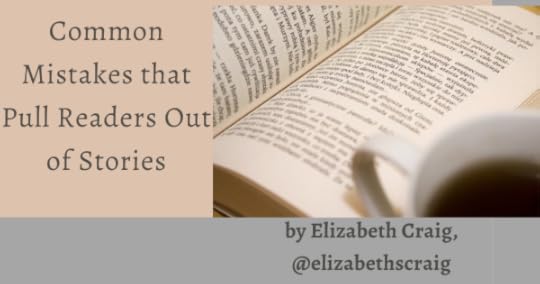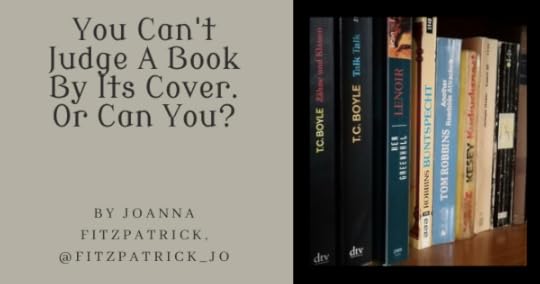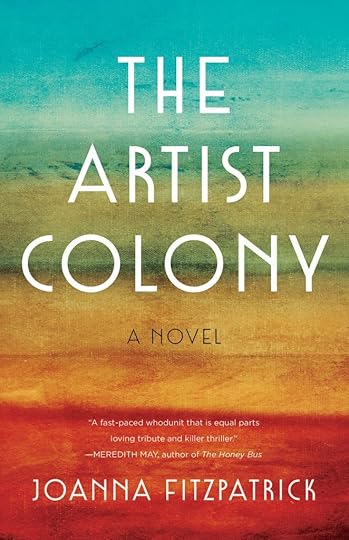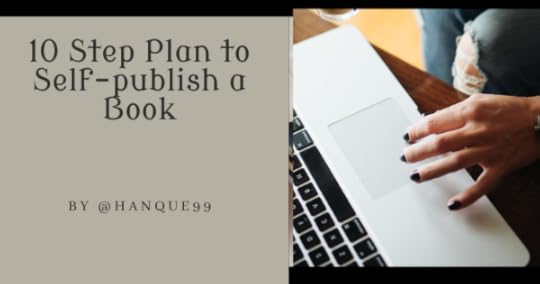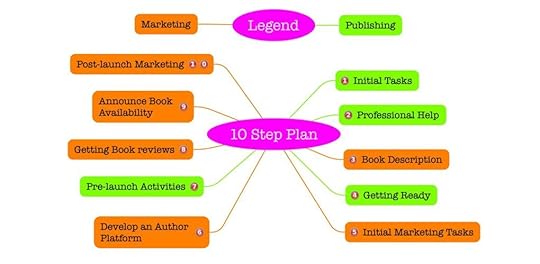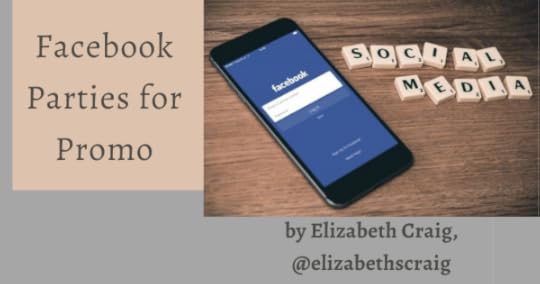Elizabeth Spann Craig's Blog, page 36
December 12, 2021
Common Mistakes that Pull Readers Out of Stories
by Elizabeth S. Craig, @elizabethscraig
There's nothing so awful as being pulled out of a great story by reading a typo. Unless, of course, you're the author of the story and a reader is telling you that they were pulled out of your story by an error.
There are lots of different mistakes that can yank readers out of a book, but the good news is that you can try to look for them before we publish…or, if you self-publish, you can correct the errors even after publishing.
Here are a few of the most-common issues that pull readers out of a story:Author intrusion. It can be very distracting when an author starts lecturing on their favorite topic or cause, especially when it doesn't fit in with the character or story.
The need for readers to suspend their disbelief too frequently. I think most readers are happy to suspend their disbelief at least once, but when it becomes a regular thing, it's frustrating.
Too much author research. Or unnatural presentation of the research. Research can be incredibly important, but not to the point where it overwhelms the story and basically turns into an information dump.
Poorly-planned or disappointing endings. Deus ex machina, among them. It's no fun to come to the end of a book you've enjoyed and the ending falls apart, is rushed, or is unbelievable.
Continuity errors. You can do a special round of edits on your story to weed these out. Readers quickly pick up on goofs where a character suddenly has a different outfit on but doesn't change clothes.
Head-hopping (shifting POVs in the same scene). It can make it hard for readers to settle in, never knowing which POV will come next.
Smart characters making dumb choices. Or even illogical behavior for a particular character that isn't in line with her personality. Characters investigating dark basements alone when there's a killer on the loose. Or even a character that acts completely out of character for no other reason but to act as a plot device.
Excessive descriptions of people or settings that don't reinforce the story world or develop the characters. I nearly always skim during long-winded descriptions. It just slows down the story's pace.
Boring or awkward dialogue. Really, it's just better not to mimic real conversations since they're not interesting when they're in print.
Too much inner dialogue. If your novel seems to have a lot of it, maybe it's time to write in a best friend to be a sounding board for your character.
Typos. We all end up with them, but it's important to get rid of as many as we can.
These are some of the main offenders to me…what would make it on your list?
Common Mistakes that Pull Readers Out of a Story:
Click To Tweet
Photo on Visualhunt
The post Common Mistakes that Pull Readers Out of Stories appeared first on Elizabeth Spann Craig.
December 11, 2021
Twitterific Writing Links
by Elizabeth S. Craig, @elizabethscraig
Twitterific writing links are fed into the Writer’s Knowledge Base search engine (developed by writer and software engineer Mike Fleming) which has over 61,000 free articles on writing related topics. It’s the search engine for writers. While you're there, check out the Writer's Digest award-winning Hiveword novel organizer.
Have you visited the WKB lately? Check out the new redesign where you can browse by category, and sign up for free writing articles, on topics you choose, delivered to your email inbox! Sign up for the Hiveword newsletter here.
Business / MiscellaneousSelf-publishing News: How Much Does Amazon Really Make from its Sellers? @agnieszkasshoes @IndieAuthorALLIConferences and Events / MiscellaneousThe IPA’s Prix Voltaire: When Neutrality Is Not an Option: @Porter_Anderson @pubperspectivesThe United Kingdom’s 2022 Portico Prize Announces Its Shortlist: @Porter_Anderson @pubperspectives2021 Wattys Awards: An Asexual Romance Takes the Top Prize: @Porter_Anderson @pubperspectives @wattpadNew Conference on ‘Foundations and Trans/Formations of Arabic Literary Theory’: @Porter_Anderson @pubperspectivesTranslator William Rodarmor Wins 2021 Albertine Prize: @Porter_Anderson @pubperspectivesCreativity and Inspiration / Goal settingGoal Setting for Writers: 6 Proven Methods to Achieve Success: @DaveChessonCreativity and Inspiration / Inspiration / Reading as Writers7 Indian Women Writers You Should Be Reading: @hirishitalkies @ElectricLitChristmas Mysteries: A Tradition Revived: @chinarhyming @CrimeReadsBad Romance: Five Books About Loving Someone Dangerous: @lisaunger @CrimeReadsAdd Books to Your Mental Health Care Routine: @BookTribWe Grow Accustomed to the Dark: Emily Dickinson’s Stunning Ode to Resilience, Animated: @brainpickerFive SF Novels Featuring Ancient Alien Artifacts: @jamesdnicollCreativity and Inspiration / Productivity / Writer's BlockGetting Unstuck: @marthamconway @WomenWritersCreativity and Inspiration / Writing LifeCo-Writing “The Relaxed Author”: @MarkLeslie @thecreativepennWriting, Yoga, and the Real You: @PamSeelig @WomenWriters10 Ways to Enhance Your Fiction Writing through Journaling: @LisaTener @LiveWriteThriveCan Fiction Make a Difference in the World? @manzanitafire @JaneFriedmanRepeat After Me: You Are NOT An ‘Aspiring Writer’: @Bang2writeHow can you fail better as a writer? @pubcoachVirtual Writers Sabbatical: Challenging a Genre Identity Crisis: @Richelle_Lyn_ @DIYMFAWould You Take This Creative Risk? (podcast) @DanBlankDo I want to make a career writing fiction? A conversation: @Roz_Morris5 Lies Writers Torture Themselves With About Their Careers: @Bang2writeHow do you deal with writing interruptions? @pubcoachSuccess Without Self-Promotion: @theladygreer @WriterUnboxedThe Most Needed Quote on Writing: @GoIntoTheStoryWriting About Grief: @AuthorSATThe 411 on Writing Retreats: @msheatherwebbLee Child on the Invention of Fiction: @LeeChildReacher @CrimeReads“How My Strategic Communications Background Helped Me Finish my Debut”: @MaanGabriel @WomenWritersSomething small, every day: @austinkleonThe principles of patience: @austinkleon“How Writing Helps Me Heal”: @LittleInfiniteGenres / FantasyDo I Need Religion in My Fantasy World? by Oren Ashkenazi @mythcreantsDreaming of Wild Horses (and Writing Them): @dancinghorse @tordotcomThe Low-Down on Urban Fantasy: by Sheree Crawford @TheRyanLanzGenres / MiscellaneousHow to write an adventure story: Creating amazing journeys: @nownovelWhat is Upmarket Fiction? And Book Club Fiction? Are They New Genres? @annerallenGenres / MysteryHow Do I Create a Satisfying Mystery Payoff? by Oren Ashkenazi @mythcreantsRituals as an Element in Crime Fiction: @MargotKinbergSwitzerland: A Crime Writing Tradition Full of Holes? @chinarhyming @CrimeReadsTasmania as a Setting in Crime Fiction: @MargotKinbergAntique shops as an element in crime fiction: @MargotKinbergGenres / Picture BooksHow Putting Together a Picture Book is Like Managing a Baseball Team: by John Briggs @TheRyanLanzGenres / Science FictionMultiverses in Science Fiction: @CEBwrites @DanKoboldtGenres / ScreenwritingIs My Screenplay Big Enough to Be a Movie? @GoIntoTheStoryScreenwriting: Does this challenge become something that’s not just hard for the hero to do (an obstacle) but also hard for the hero to want to do (a conflict)? @CockeyedCaravanGenres / Short Stories6 Important Things About Flash Fiction: @MiaJouBotha @Writers_WritePromo / Miscellaneous5 Reasons to Join Author Street Teams: @khogrefeparnell @EdieMelsonPromo / NewslettersHow and When to Clean Up Your Newsletter’s Subscriber List: @inkbitspixelsPromo / Social Media Tips5 Habits Of Writers With Great Twitter Brands: @brotzel_fiction @Writers_WritePromo / WebsitesSearch Engine Optimization for Novelists: @SnowflakeGuyPublishing / News / DataUS Book Market Up 13.7 Percent YTD : AAP StatShot for October: @Porter_Anderson @pubperspectivesPublishing / News / International PublishingAt the Alliance’s Conference in Spain: African Publishers on Their Challenges: @oliviasnaije @pubperspectivesWords Without Borders: Kaaps Writings From South Africa: @Porter_Anderson @pubperspectives @wwbordersGuest of Honor Peru at Guadalajara: Overcoming a 30-Percent Pandemic Drop: by Adam Critchley @pubperspectivesSpringer Nature Plants Trees in India, One for Each Employee: @Porter_Anderson @pubperspectivesGermany's Börsenverein Cheers EU Flexibility on VAT Rates for Books: @Porter_Anderson @pubperspectivesCanada's 10-Year Publishing Crisis : ‘This Broken Copyright Framework': @Porter_Anderson @pubperspectivesYear’s End: Italian Comics’ Audience Approaches 9 Million Readers: @Porter_Anderson @pubperspectivesPublishing / Options / Hybrid PublishingTransitioning From a Self-Published to Hybrid Author: @karentoz @NatalieIAguirrePublishing / Options / Traditional Publishing / QueryingHow (and why) to personalize a query letter: @NathanBransfordPublishing / Process / Book DesignYou Can’t Judge A Book By Its Cover. Or Can You? @Fitzpatrick_joTips for Better Book Covers: @FrugalBookPromoThe 10 best Goosebumps covers, ranked: @jessiegaynor @lithubPublishing / Process / ISBNsThe Comprehensive Book ISBN Guide for Authors: @claytonnoblit @WrittenWordMWriting Craft / BeginningsGreat Beginnings: @rachelsdempsey @RMFWritersCrafting Your Novel’s First Line: @GGCWrites @GoodStoryCoWriting Craft / Characters / AntagonistsArchetypal Antagonists for the King Arc: Cataclysm and Rebel: @KMWeilandWriting Craft / Characters / ArcThe Heroine’s Journey: Part 1: @GoIntoTheStoryThe Heroine’s Journey: @GoIntoTheStoryWriting Craft / Characters / DevelopmentWhy My Favorite Characters to Write Are Often Unsympathetic and Unforgivable: @AskoldMelnyczuk @lithubArchetypal Antagonists for the Crone Arc: Death Blight and Tempter: @KMWeilandHow to Create Nuanced Characters: by Nina Schuyler @LiveWriteThriveWriting Craft / Characters / ProtagonistsHow To Properly Introduce Your Protagonist: by PJ Parrish @killzoneauthorsWriting Craft / Common MistakesWhy the Stories You Write Must Have a Problem: @PeggySueWells @EdieMelsonWriting Craft / Lessons from Books and FilmPage One: “Three Kings” (1999): @GoIntoTheStoryPage One: “Traffic” (2000): @GoIntoTheStoryScript To Screen: “A Few Good Men”: @GoIntoTheStoryThe Expanded Ultimate Story Checklist: Does something inside the hero have a particularly volatile reaction to the challenge? @CockeyedCaravanWriting Craft / MiscellaneousThe Art of Showing Vs. Telling: @LJC__Writing @TheRyanLanzDon’t Gild Your Lilies: @jamesscottbellNavigating a Story Identity Crisis: @KarenDeBonisAdvice Is NOT Universal: @Frank_Zafiro @CrimeReadsPoints of a Story: 6 Key Plot Points That Every Story Needs: by @joebunting @write_practiceWriting Craft / POVHow to Write Point of View: Third Person Distant: @harmony_kent @StoryEmpireWriting Craft / Pre-Writing / Story ConceptHow to develop a story idea: 7 essential exercises: @nownovelWriting Craft / Revisions / CritiquesWhen to get feedback on a novel: @NathanBransfordWriting Craft / ScenesScene Structure According to Dwight V. Swain: @SeptCFawkesWriting Craft / Series3 Ways to Write a Series: @MBjorkWritesWriting Craft / Settings and DescriptionHow Can Writers Make Description Evocative? by Chris Winkle @mythcreantsWriting Craft / SubtextLove on the Spectrum: Understanding Subtext: @thejkstudioWriting Tools / AppsPodcast: How to Dictate a Novel with Kevin J Anderson: @TheKJA @BookTrib
The Top Writing Links From Last Week Are On Twitterific:
Click To Tweet
The post Twitterific Writing Links appeared first on Elizabeth Spann Craig.
December 5, 2021
You Can’t Judge A Book By Its Cover. Or Can You?
by Joanna Fitzpatrick, @Fitzpatrick_jo
The long and short of it is: how do you come up with a compelling 5.5″ by 8.5″ book cover suitable for a bookstore window (if you get that lucky) and which is also suitable when reduced to a postage stamp image digitally displayed online, which is where most books are seen and sold today?
Before I became a writer, I designed LP record jackets. For any one of you who have ever lovingly held an LP in your hand, admired its “artwork,” and then slipped the disc out of its sleeve, placed the turntable needle on the rim of the black vinyl recording and sat down to listen while reading the liner notes on the back of the jacket – let me just say “those were the days.”
When CDs (4.75″ square) and Cassettes (smaller than a smartphone) arrived on the music scene it required a very different creative approach because there was little room for artwork, liner notes or even space to list musicians. And today, just like books, most “albums” are sold digitally by displaying a postage-stamp size cover with limited information.
Okay. So we are aware of the limitations of today's cover artwork, be it book covers or album covers, but there's a lot you can still do to have a terrific cover IF you have an art designer willing to work with you as I do. But be respectful of their time. They have to produce hundreds of covers under deadline. In other words, show diplomacy: speak softly and carry a big stick!
But first you need an engaging book title. My original title for “The Artist Colony” was “The Sketch Box.” I called it “The Sketch Box” because I needed to have something to call it other than “the book” or in my darkest hour “the beast.”
A sketch box is an artist's box carried by plein air painters, like a briefcase, with the art supplies needed to paint outdoors. Only painters would know this and it wouldn't conjure up any intrigue to read it. It's what's called, let's face it, a “bad title.” My novel was an historical mystery not a how-to-paint book. Working titles are often wrong, but we get attached to them, like our darlings that we later edit out of of our books or our editor does it for us.
I knew I had done the right thing when I changed the title to “The Artist Colony” because images immediately came to mind for a book cover.
My novel is about two sisters who were artists. Ada Belle dies under suspicious circumstances and her sister Sarah becomes an amateur sleuth to find out the truth. I sought online for an image of a messy painter's palette covered in thick, oily globs of glossy black and blood-red paint. I found just such a palette on internet and proudly sent it off to my publisher's art department.
The designers reviewed my ideas but the mock-ups they sent back showed me that they were designing a generic cover based on their concept of what a historical mystery was. Obviously, they hadn't read my book. How could they have the time! Does this sound familiar? The reality of working with a commercial book publisher has to be overcome.
I wrote back and said politely that if they wanted to have an image of two sisters then show them as they really are in my story: stylish Manhattan female artists who would be found at a speakeasy or a bohemian garden party wearing peacock feathered hats, flamenco shawls and stilettos. Not frilly pastel dresses that were worn by the sisters in the movie “Little Women.” Historical, yes, but inaccurate and where was the mystery?
All was not lost. They had come up with another mock-up from one of my other cover ideas that I liked a lot. It was a painting of a seascape that had texture like a painter's canvas. And they'd come up with a stunning 1920s art deco font for the title that fit the time period. Yay! We were getting closer. Only the story's plot was missing. A plot that would sell my book through it's compelling cover.
I gave the designer my elevator pitch: “The Artist Colony” is a page-turner story of bohemian artists, rum runners, racial unrest, suicide, art forgery, and dead bodies found in a bucolic1920s art colony.
Since they would never read the book anyway, that seemed to be just what they needed. The next seascape mock-up was dramatically darker and foreboding. The only change I then requested was to enlarge and brighten the title font and my name for stronger visibility. Remember we are talking about a miniature image. The designer did as I asked and voila! we had a cover. At first I thought this will never happen but at the end I was happy.
I'm a big fan of well-designed book covers. I'd love to hear from other writers as to how they designed their book cover or from readers who may have bought a book because of its cover.
And, of course, I would be curious to know if you think my book cover accomplished what I was looking for or not?
JOANNA FITZPATRICK was raised in Hollywood. She started her writing habit by applying her orange fountain pen and a wild imagination to screenplays, which led her early on to produce the film White Lilacs and Pink Champagne. Accepted at Sarah Lawrence College, she wrote her MFA thesis Sha La La: Live for Today about her life as a rock ’n’ roll star’s wife. Her more recent work includes two novels, Katherine Mansfield, Bronze Winner of the 2021 Independent Publisher Book Award (IPPY) in Historical Fiction, and The Drummer’s Widow. The Artist Colony is her third book. Presently, FitzPatrick divides her time between a cottage by the sea in Pacific Grove, California and a hameau in rural southern France where she begins all her book projects. Find her online here:
Author website: www.joannafitzpatrick.com
Facebook: www.facebook.com/JoannaFitzPatrickauthor
Twitter: https://twitter.com/Fitzpatrick_jo
Instagram: https://www.instagram.com/joannafitzpatrick.author/
Tips for Giving Input to Your Cover Designer by @Fitzpatrick_jo :
Click To Tweet
Photo credit: erix! on VisualHunt
The post You Can’t Judge A Book By Its Cover. Or Can You? appeared first on Elizabeth Spann Craig.
December 4, 2021
Twitterific Writing Links
by Elizabeth S. Craig, @elizabethscraig
Twitterific writing links are fed into the Writer’s Knowledge Base search engine (developed by writer and software engineer Mike Fleming) which has over 61,000 free articles on writing related topics. It’s the search engine for writers. While you're there, check out the Writer's Digest award-winning Hiveword novel organizer.
Have you visited the WKB lately? Check out the new redesign where you can browse by category, and sign up for free writing articles, on topics you choose, delivered to your email inbox! Sign up for the Hiveword newsletter here.
Business / MiscellaneousHow to Work with an Audiobook Narrator with Jillian Yetter: @sacha_black6 Ways Writers Protect Online Privacy: @WordDreamsThree Things You May Not Know About Being a Freelance Editor: @FinishedPages @womenonwritingWhat to Expect When Your Novel is Reissued: by Alma Katsu @WriterUnboxedHow to Set Effective Boundaries With Freelance Clients: @quiettypeblogHow to protect your manuscript from computer meltdowns and hackers: by Lindsay Syhakhom @NathanBransfordSelf-publishing News: 7th Consecutive year of Double Digit Audio Growth: @agnieszkasshoes @IndieAuthorALLIA Report from the Futurebook Conference; Spotify Buys Findaway in Audiobook Game-Changer: @agnieszkasshoes @Howard_Lovy @IndieAuthorALLIThe Secret to Choosing a Freelance Writing Niche: @quiettypeblogConferences and Events / MiscellaneousThe 2021 Albertine Prize Shortlist: Five French Works in Translation: @Porter_Anderson @pubperspectivesMarjoleine Kars Wins the $75,000 Cundill History Prize: @Porter_Anderson @MarjoleineKars @CundillPrize @pubperspectivesCreativity and Inspiration / Inspiration / Reading as WritersWhen C.S. Lewis Reviewed His Buddy’s Book… The Hobbit: @bookmarksreads @lithubCustomer Service as a Feature in Crime Fiction: @MargotKinbergRiff on a Myth: 7 Novels Drawing Inspiration From Multicultural Ancient Sources: by Judy Moreno @BookTribCreativity and Inspiration / Productivity / Fitting in WritingHow to Create a Morning Writing Routine That Works: @radekpazderaHow To Actually Get Writing Done: @writingandsuchMake Time For Your Writing: @aprildavilaQuick Writing Tip: Make a Note to Your Future Self in Your WIP: by Bucket Siler5 Ways to Trick Yourself into Writing: by LA Bourgeois @DIYMFACreativity and Inspiration / Writing LifeToo Much Writing Advice — Critical Thinking Skills: @Peter_Rey_Three Ways to find Joy in the Creative Journey: @kirsticallImportant Times to Break a Writing Rule to Boost Productivity: @colleen_m_storyDo You Want to Write? Or Do You Want to Publish? by Deborah DeArmond @A3writersHow to get from where you are to where you want to be: @pubcoachDon’t Just Write It. Live It: @ElleEIre @FloridaWriters1Could Binge-Writing be Right for Me? @diannmills @EdieMelsonBusiness Musings: Comparison is the Thief of Joy: @KristineRuschBrave New Writing and Learning to Think Outside the Book: @KristenLambTXWriter Burnout: 19 Tips for Recovery and Prevention: @StoryHobbit @DaveChessonWriting and the Creative Life: Seeing… Hearing… : @GoIntoTheStoryFlights of Self-Censorship: @Porter_Anderson @WriterUnboxedWhy THIS Story? @magpie0218 @RMFWritersLearn What You Don't Know and Write That: @craigvonbuseck @EdieMelsonGenres / MemoirSpeculative Memoir: Making the Invisible Visible: @laraineherring @CleaverMagazineIf It’s Worth Living, It’s Worth Recording: Thoughts on Memoirs: by Lucie Ataya @KiingoCreativeGenres / MysteryTunnels as an Element in Crime Fiction: @MargotKinbergMysteries: Perceived Unreliability as an Element: “How I Started Writing Cozy Mini Mysteries for Woman’s World (and Published a Book)”: by Loretta Martin @womenonwritingThe Relationship Between Readers and Writers in Crime Fiction: @MargotKinbergGenres / Picture BooksPicture Books – Which Comes First, Story or Illustrations? @KarenCV @FrugalBookPromoGenres / PoetryHaiku…an Introduction: by Joyce Hooley and Steve Hooley @killzoneauthorsGenres / RomanceHow to Create a Romance Novel Outline: @hannahxyang @ProWritingAidUse These 81 Romance-Writing Prompts to Start Your Next Romance Novel: @KrystalNCraiker @ProWritingAidPromo / BloggingWhy Blogging is Important for Writers: by Shelley Widhalm @TheRyanLanzPromo / MiscellaneousHow to Ask For, and Give, Book Blurbs: @richardgthomas3 @LitReactorPublishing / MiscellaneousPersistence and Publishing, a Debut Author’s Story: @unefemmejames @DIYMFAOpen Road's Acquisition Investors Include Steinberger, Entrekin: @Porter_Anderson @OpenRoadMedia @pubperspectivesOpen Access Wars : Springer Nature Announces One Million OA Articles: @Porter_Anderson @pubperspectivesPublishing / News / International PublishingAt Guadalajara: Spain’s Publishers Present a 41-House Collective Stand: @Porter_Anderson @pubperspectivesChina Bestsellers: New Editions Buoyed October’s Fiction Market: @Porter_Anderson @pubperspectivesThe UK's Publishers Association Charts a ‘Steep Rise' in Audiobook Sales: @Porter_Anderson @pubperspectivesThe Börsenverein Welcomes Principles of the German Coalition’s Draft: @Porter_Anderson @pubperspectivesA Czech Second-Hand Books Boom: Knihobot’s Big Year: @jaroslawadamows @pubperspectivesNielsen's Look at Audiobooks in the United Kingdom : ‘Curiosity, Multitasking': @Porter_Anderson @pubperspectivesThe International Alliance of Independent Publishers in Pamplona-Iruñea: @oliviasnaije @indpuballiance @pubperspectivesMalaysian Publisher Syazrul Aqram: ‘Keep On Moving Forward’: @Porter_Anderson @pubperspectivesIPA’s Prix Voltaire Ceremony at Guadalajara: Grief, Outrage, Honor: @Porter_Anderson @pubperspectivesYear’s End: Italian Publishers Expect 2021 Growth of at Least 12.6 Percent: @Porter_Anderson @pubperspectivesRights Roundup: Text and Light From ‘The End of the World’: @Porter_Anderson @pubperspectivesPublishing / Options / Traditional PublishingWhen You Want to Switch Agents, but Not Agencies: @BookEndsJessicaPublishing / Options / Traditional Publishing / QueryingWhat’s a good subject line for a query email? @RachelleGardnerElements of a Query Letter: by Amy Wilson @GoodStoryCoPublishing / Process / Book DesignThe perils of book cover design: @pubcoachPublishing / Process / ContractsContracts for Creatives: a Glossary: @KathrynGoldman @IndieAuthorALLIPublishing / Process / FormattingHow to Format Your Manuscript for a Designer or Publisher: @HederisApp @JaneFriedmanHow to Format a Book: 12 Tools & 10 Tips: @DaveChesson @smartbloggerhqWriting Craft / BeginningsFirst Page Critique: Using Setting And Action To Inject Suspense: by PJ Parrish @killzoneauthorsWriting Craft / Characters / DevelopmentCharacter Archetypes: 15 Examples [+Template]: @DaveChessonKnow Who Your Characters Are: by Celeste October @NaNoWriMoResources For Creating Characters: @writingandsuchSetting Goals for Your Characters: from How to Fight WriteWriting Craft / Characters / Protagonists“Where am I going?” A Question for Your Protagonist to Answer: @GoIntoTheStoryWriting Craft / Common Mistakes4 Deadly Writer Sins—and How to Avoid Them: @RuthHarrisBooksWriting Craft / Lessons from Books and FilmHow Useful Are Neil Gaiman’s Eight Rules of Writing? by Oren Ashkenazi @mythcreantsPage One: “Thor: Ragnarok” (2017): @GoIntoTheStoryWriting Craft / MiscellaneousShock vs. Subverted Expectations: @stacitroilo @StoryEmpireOne Way to Quickly Improve Your Writing: @JerryBJenkins @NinaAmirDetermining How Many Active Characters to Have in a Scene: from Fix Your Writing HabitsFollowing a characters first, story second method: @writingandsuchWriting Craft / POVBest Pro Tip For Writing in Deep POV: @LisaHallWilsonWriting Craft / Pre-Writing / NamingThe Importance of A Name for Your Novel's Characters: @AneMulligan @EdieMelsonWriting Craft / Pre-Writing / OutliningHow To Outline Your Novel. Or Not. @HankPRyan @CareerAuthorsWriting Craft / Punctuation and GrammarHow to Use Punctuation Marks — the Period (Full Stop): @Peter_Rey_Sprinkle on the Conjunctions: @nlholmesbooks @FloridaWriters1Writing Craft / Settings and DescriptionResearching Settings: @WritersCoachWriting Craft / VoiceThe Art of Writing Styles: How to Find Your Voice as a Writer: @ByMichelleRenee
The Top Writing Links From Last Week Are On Twitterific:
Click To Tweet
The post Twitterific Writing Links appeared first on Elizabeth Spann Craig.
November 28, 2021
Mysteries: Perceived Unreliability as an Element
by Elizabeth S. Craig, @elizabethscraig
I started reading the cozy mystery master Agatha Christie at a very impressionable age and loved the construction of her books and the characters she created.
There were a couple of elements of her books that especially stuck with me and they both involved unreliability of characters. Reliability, or perceived unreliability, can have a big role in mysteries.
Seemingly Unreliable SleuthsAgatha Christie was a master at creating sleuths that could be easily underestimated. Miss Marple might come immediately to mind, but she intended her brilliant Hercule Poirot to be, as well…he could behave cartoonish at times and was considered a foreigner by other characters.
These unreliable, easily underestimated sleuths had the ability to fly under the radar. Instead of putting suspects on their guard, they tended to either lull them into confidences (Miss Marple) or just often not seem intimidating at all (Poirot). Suspects then could accidentally drop clues that might point to the murderer or provide gossip that could help better fill in a picture of other suspects.
Seemingly Unreliable WitnessesThis was another element Agatha Christie used in her mysteries. Often there was a character who the other characters would sort of roll their eyes over. They might seem scatterbrained or flighty or hesitant. They would offer a clue or some bit of information that everyone would discount because of who provided it. Unfortunately for the character, they'd usually get murdered because the killer would realize they did know something vital. The character would be eliminated before he or she could offer any other information.
These elements are still useful for mysteries today and provide great ways to uncover more clues in the story. As a reader, do you recognize these seemingly unreliable characters? If you're a mystery writer, have you used them (I have)?
Perceived Unreliability as an Element in Mysteries:
Click To Tweet
Photo on Visualhunt.com
The post Mysteries: Perceived Unreliability as an Element appeared first on Elizabeth Spann Craig.
Twitterific Writing Links
by Elizabeth S. Craig, @elizabethscraig
Twitterific writing links are fed into the Writer’s Knowledge Base search engine (developed by writer and software engineer Mike Fleming) which has over 61,000 free articles on writing related topics. It’s the search engine for writers. While you're there, check out the Writer's Digest award-winning Hiveword novel organizer.
Have you visited the WKB lately? Check out the new redesign where you can browse by category, and sign up for free writing articles, on topics you choose, delivered to your email inbox! Sign up for the Hiveword newsletter here.
Business / MiscellaneousReaching the Bestseller List: A Guide for Self-Published Authors: @claytonnoblit @WrittenWordMWhat is Upmarket Fiction? @BookEndsJessica @bookendslitISBN Bar Code Generator: @DaveChessonConferences and Events / MiscellaneousUS National Book Awards: The 2021 Winners: @Porter_Anderson @nationalbook @pubperspectivesGuatemala’s F&G Editores Wins AAP’s Freedom to Publish Award: @Porter_Anderson @pubperspectivesAt London's FutureBook : Onstage and on the Ether: @Porter_Anderson @pubperspectivesLebanon’s Dar Al Jadeed Wins IPA’s 2021 Prix Voltaire: @Porter_Anderson @pubperspectivesThe Saif Ghobash Banipal Prize for Arabic Translation Names Its Shortlist: @Porter_Anderson @pubperspectivesAn Exposé of the ‘Ostarbeiter' Wins the 50,000-Franc Jan Michalski Prize: @Porter_Anderson @pubperspectivesThe United Kingdom’s Costa Book Awards Name Five Shortlists: @Porter_Anderson @pubperspectivesAt Guadalajara: Bologna Children’s Book Fair Makes Its Next Stop: @Porter_Anderson @pubperspectivesCreativity and Inspiration / Goal setting5 Ways to Bring Your Writing Ideas (and Career) to Life: @NinaAmirCreativity and Inspiration / Inspiration / Reading as WritersBooks, Film, and TV to Inspire Surrealist Writing: @mhbertino @ElectricLit5 SF Stories in Which Kindness Prevails: @jamesdnicoll @tordotcom7 Flash Fiction Collections You Should Be Reading: @DDressick @ElectricLit5 Books Featuring Fantasy Clergy: @MarRogerson @tordotcomCreativity and Inspiration / Productivity / Fitting in WritingEvery Word Written is a Small Success: by Jill KemererHow to Be a More Disciplined Writer: @radekpazderaCreativity and Inspiration / Writing LifeHow to Keep Technology from Interfering with Your Writing and Speaking Life: @YvonneOrtega1 @EdieMelsonEverything Has A Story: @EldredBirdWhy Write This Book? @jennienash @JaneFriedman8 Online Bookshops Owned by Black Women: by Kelsey Gooden @LittleInfiniteRecovering From a Bad Publishing Experience: @JohnDoppler @IndieAuthorALLIFocus On Your Strengths As An Indie Author To Beat ‘Comparison-itis:’ @OrnaRoss @thecreativepenn @IndieAuthorALLIWhy You Should Start Journaling: by Lucie Ataya @KiingoCreative5 Authors, 7 Questions, No Wrong Answers: @TeddyWayne1999 @lithubCreative Waste is Part of the Creative Game: @kadavyPodcast: The Power of Clicking “Publish”: @DanBlankInspirational Indie Author Interview. Denise Baden: Climate Fiction Author Seeks Optimistic Shade of Green: @DABadenauthor @Howard_Lovy @IndieAuthorALLI“Why I deleted my Kindle Vella story”: @DwallacepeachAre you making creative mistakes? @pubcoach5 Lies Writers Torture Themselves With About Their Projects: @Bang2write5 Tips for Starting a Journaling Habit: @MichaelHyattNinety-Nine Ways to Fail in Writing, Publishing, and Marketing: by Kent Gustavson @bloomingtwigA Writer’s Senses Working Overtime: @VaughnRoycroft @WriterUnboxedWhen the book came out, I left my job. The Creative Shift of Author Nicole Blades : @NicoleBlades @DanBlankA Great Storyteller Loses His Memory: @rodgarciafilm @parisreviewGenres / FantasyWriting Neurodivergent Characters in Fantasy: @Emma4Lammers @mythicscribesGenres / Horror10 Most Common Bigfoot Clichés: by Deborah Sheldon @HorrorTreeWhen ‘The Power’ Goes Out: 10 of the Scariest Scenes in Horror That Take Place in the Dark: @HauntedMeg @BDisgustingGenres / Literary FictionLiterary Fiction: What Is It? @Roz_Morris @SelfPubFormGenres / MiscellaneousTravel Writing Tips: @jeremybassetti @thecreativepennAlone in the Garden of Good and Evil: Daryl Gregory on the Southern Gothic: @darylwriterguy @TorNightfireGenres / MysteryThe 5 Pillars Of Police Procedurals: @Writers_WriteGenres / PoetryAdvice for someone wanting to publish a first-time poetry collection: @RachelleGardnerGenres / Science FictionQuantum Mechanics I: Uncertainty, Observation, and the Quantum Retcon: @CEBwrites @DanKoboldt17 Iconic Fashion Moments in SFF History: @Ryality @tordotcomGenres / ScreenwritingScene Description Spotlight: “Wall-E”: @GoIntoTheStoryThe Business of Screenwriting: It’s not just about the script: @GoIntoTheStoryReader Question: Who is the Nemesis in “character driven” films? @GoIntoTheStoryMovie Script Scene-By-Scene Breakdowns: @GoIntoTheStoryGenres / Young AdultThe Importance of Friendships in YA: @SoniaHartl1 @DIYMFAPromo / MiscellaneousGuesting 101: How to Be a Good Guest on a Blog, Podcast, or Video Show: @DebraEckerling5 Free Book Marketing Strategies You Should Revisit Quarterly: @BookgalWhy Self-Publishing a Book Makes You a Marketer: @BookgalHow to Connect Your Marketing to Special Dates: @KarenHWhiting @EdieMelsonPromo / PlatformsThe Importance of Defining Your Online Writer Brand: by Lucie Ataya @KiingoCreativePromo / Social Media TipsTikTok Tips for Authors: @haayleyhaggertyPublishing / MiscellaneousWebtoon Book Group Opens Graphic Novel Imprint, Unscrolled: @Porter_Anderson @pubperspectivesAAP's New Initiatives on Sustainability, Diversity in Book Publishing: @Porter_Anderson @pubperspectivesAnother Medium for Story Tellers: Video Games: @WordyRobin @TheIWSGPublishing: ‘Fings Ain’t Wot They Used T’Be: @rcharkin @pubperspectivesWriting And Producing Audio Drama And Podcast Fiction: @SarahRheaWerner @thecreativepennPublishing / News / International PublishingAt Sharjah: A UNESCO World Book Capital Network Meeting: @Porter_Anderson @pubperspectivesPublishing / Options / Traditional PublishingThe Cost of Being an Agent: @BookEndsJessica @bookendslitNavigating the Agent-Author Relationship: @TashaRelph @WomenWritersPublishing / Options / Traditional Publishing / QueryingAgent Spotlight: Danielle Chiotti Interview and Query Critique Giveaway: @daniellechiotti @NatalieIAguirreLoglines versus Queries: @MorganHzlwoodPublishing / Process / ContractsBook Contracts: Let’s Talk Surprises: @kate_mckean @CatapultStoryBook Contracts: Let’s Talk Rights: @kate_mckean @CatapultStoryPublishing / Process / Services to AvoidWarning to Writers: You Won’t See This New Publishing Scam Coming: @annerallenWriting Craft / BeginningsFlog a Pro: Would You Pay to Turn the First Page of this Bestseller? @RayRhamey @WriterUnboxedWriting Craft / Chapter EndingsWriting Ending Hooks for Difficult Chapters: @ZoeMMcCarthyWriting Craft / Characters / DevelopmentA Counselor’s Perspective on Creating Character Driven Novels: @amandacoxwritesWriting Insecure Characters: @LisaHallWilsonWriting Morally Ambiguous Characters: @MBjorkWritesCharacter Types: The Introvert: @JoanHallWrites @StoryEmpireWriting Craft / Characters / ProtagonistsThe Passive Protagonist Problem: @KelseyAllagood @WriterUnboxedHow Do I Give My Protagonist Agency? by Oren Ashkenazi @mythcreantsWriting Craft / Characters / Supporting CharactersSeven Essential Aspects of a Strong Secondary Character: by Cady Hammer @kristen_kiefferPopulating Your Story with Background Characters: by Jan Drexler @SKRViLLWriting Craft / Common MistakesStory Not Behaving? Try Going Deeper into Structure: @JamiGold @onestop4writersWriting Craft / ConflictSecondary Stressors in Your Story: by CS Boyack @StoryEmpire6 Types of Conflict to Use For Memorable Stories: @JerryBJenkinsWriting Craft / DiversityHow to Write Diverse Characters (And, Also, Are You Qualified?): by Joiya Morrison-Efemini @GoodStoryCoAssigning race to a character that dies in preventable accident: @WritingwColorBringing Omitted BIPOC History to Light through Middle Grade Picture Books: Interview with Traci Sorell and Carole Boston Weatherford: @DIYMFAAbsent, but loving, Black military father? @WritingwColorWriting Craft / EndingsHow To End A Novel: by Rhiannon Richardson @GoodStoryCoWriting from the End: How Endings Create Satisfying Beginnings in a Book: @writeabookWriting Craft / Lessons from Books and FilmSeeking a More Tranquil Mind? Take Horace’s Advice: by Alan Jacobs @lithubGreat Scene: “Boogie Nights”: @GoIntoTheStoryScript To Screen: “As Good As It Gets”: @GoIntoTheStoryWriting Craft / MiscellaneousCan Ghostwriting Make You a Better Novelist? by Eva Shaw @WomenWritersCritical Analysis—An Essential Part of Your Process: @richardgthomas3 @LitReactor5 Tips for Writing Fiction: @KhanhHa69784776 @DIYMFA3 Things to Do When You Can’t Use Your Favorite Writing Style: by Pekoeblaze @TheRyanLanzWrite With Your Eyes Closed: @jamesscottbell @killzoneauthorsStory planner success: How to organize your novel: @nownovelWriting Craft / Pre-Writing / Story ConceptWhat are good topics for novels? 14 ways to find winners: @nownovelWriting Craft / Punctuation and GrammarNix the Italics: @DLoockUsing Text Messages in Fiction: by Marilynn ByerlyAvoid Grammatical Tautologies so You Never Say the Same Thing Twice: @StraightUpYou @lifehackerFragmented Sentences – How Bad are They: @AJHumpageWriting Craft / RevisionThe Rewriting Process: @LJC__Writing @TheRyanLanzWriting Craft / Scenes6 Tips to Make Your Scenes Visually Dynamic: @LiveWriteThriveScene Outline: How to Write Faster by Developing a List of Scenes: @JDEdwinAuthor @write_practiceWriting Craft / Settings and DescriptionBeyond Description: Story-Relevant Aspects of Setting: by Barbara Linn Probst @WriterUnboxedWriting Craft / VoiceHow To Develop A Distinct Voice In Your Writing: @writingandsuchWriting Craft / Word Crafting67 Stupidly Brilliant (& Seriously Fun) Oxymoron Examples: by Mary Anne Shrew @smartbloggerhqIdioms and slang: two examples: by Anatoly Liberman @OUPAcademicWriting Tools / BooksCreative Writing Resources for Writers to Improve Their Craft: @TheCaregiversR1 @jamesscottbellUncategorizedIngram’s Lightning Source Opens Print-on-Demand Facility at Sharjah: @Porter_Anderson @pubperspectives wkb64Self-publishing News: Futurebook 2021 – Very Different Visions of the Future of Audio: @agnieszkasshoes @IndieAuthorALLI
The Top Writing Links From Last Week Are On Twitterific:
Click To Tweet
The post Twitterific Writing Links appeared first on Elizabeth Spann Craig.
November 20, 2021
Twitterific Writing Links
by Elizabeth S. Craig, @elizabethscraig
Twitterific writing links are fed into the Writer’s Knowledge Base search engine (developed by writer and software engineer Mike Fleming) which has over 61,000 free articles on writing related topics. It’s the search engine for writers. While you're there, check out the Writer's Digest award-winning Hiveword novel organizer.
Have you visited the WKB lately? Check out the new redesign where you can browse by category, and sign up for free writing articles, on topics you choose, delivered to your email inbox! Sign up for the Hiveword newsletter here.
Happy Thanksgiving to my US blog readers! I'm taking this week off to observe the holiday. See you back here in a week. :)
Business / MiscellaneousHow to Sell More Books Direct to Consumer (Yes, We Mean Sidestepping Amazon): @BookgalSelf-publishing News: Spotify Buys Findaway and Changes Audiobooks Overnight: @agnieszkasshoes @IndieAuthorALLIHow to Snag the Best Freelance Editor for Your Writing Project: @JodieRennerEd @annerallenConferences and Events / MiscellaneousGermany's BücherFrauen Award Mely Kiyak With Their First ‘Christine': @Porter_Anderson @pubperspectivesJakTent Concludes in Indonesia, a Festival Cheered by UNESCO’s News: @Porter_Anderson @pubperspectivesSharjah Reports 1.69 Million Attendees at 40th International Book Fair: @Porter_Anderson @pubperspectivesPatrick Radden Keefe Wins the UK’s Baillie Gifford Prize for ‘Empire of Pain’: @Porter_Anderson @praddenkeefe @pubperspectivesLooking Ahead to Thessaloniki International Book Fair: ‘A New Era’: @oliviasnaije @pubperspectivesCreativity and Inspiration / Inspiration / Reading as Writers8 Memoirs of Women Hiking in the Wilderness: @annabelabbs @ElectricLitHow to Get Back Into Reading: @BrynDonovan5 Books About Death and What Comes Next: @tjklune @tordotcom5 Books That Treat Friendship as Seriously as Romance: @wirewalking @tordotcomCreativity and Inspiration / Writing LifeAn Ode to Sticky Notes: @pdtoler @WomenWriters6 Proactive Actions You Can Take To Let Your Writing Flow: @TheLeighShulmanBest Gifts for Writers: @RobynRosteHow To Reboot: by PJ Parrish @killzoneauthorsRocky Rinse And Repeat: @pathatttime @TheIWSG8 Lessons on Writing (Learned from Home Improvement): @FoxPrintEdHow to stop writing a novel: @NathanBransfordThe Perfect Day Begins with a Good Evening (or My Night Time Routine): @RyanHolidayWhy So Many People Write at Starbucks: by Larry Kahaner @TheRyanLanz10 Years of LitReactor News: A Follow-up: @helpfulsnowman @LitReactorWhy You Need to Ask Better Questions About Your Writing Journey: by Lucie Ataya @KiingoCreativeReasons to Write a Book — Some Probably Better than Others: @Peter_Rey_Gift List for Indie Authors: @IndieAuthorALLIWrite, and Live Forever: @jamesscottbell @killzoneauthors“How I Use ‘Soundtracks' To Help Me Write When I’m Not Writing”: by Matt Frick @TheRyanLanzGenres / MemoirHow narrative memoir journaling can improve your nonfiction: by Chelsea Leah @TheWriterMagGenres / MiscellaneousThe Ultimate Guide to Understanding Your Book Genre: @IndieAuthorALLIPodcast: Blending the Lines of Genre with Joyce Carol Oates: @BookTrib @JoyceCarolOatesGenres / PoetryWhy a poet's community is so important to writers – no matter their experience: @poetrycoveGenres / RomanceThe Balance of Romantic Suspense: by Dezi Golden @MandSMagazineGenres / Science FictionSo, you think your publication is working to advance equity in SFF? @followthelede @sfwaBuilding Mass Effect: How Bioware Imagines the Future: by Oren Ashkenazi @mythcreantsGenres / ScreenwritingMany Film Protagonists Have Fear as a Commonality: @savethecatReader Question: How insane is it for a 46 year-old to try to start a Hollywood writing career? @GoIntoTheStoryScript To Screen: “Black Swan”: @GoIntoTheStoryPromo / AdsGetting Started with BookBub Ads: Driving Series Sales: @CarlynAtBookBub @BookBub“The Amazon Ad that Changed My Author Career”: @bryancohenbooks @DaveChessonPromo / Blogging3 Book Marketing Tactics Perfect For Bloggers: @BirdsOAFpress @NinaAmirDo I Have to Blog To Be Successful At Writing? (Podcast): @MichaelLaRonn @OrnaRoss @IndieAuthorALLIPromo / MiscellaneousAn Introduction to Multicultural Marketing: @SusetteBrooks @penguinusaPromo / NewslettersHow to reach fellow writers with a newsletter: @WildMelissaHart @TheWriterMagPublishing / MiscellaneousWho's Who in Your Publishing Village: @sl_penner @WriterUnboxedAmazon Publishing's Eoin Purcell : ‘Surprise Books' and Pandemic Effects: @Porter_Anderson @eoinpurcell @pubperspectivesAhead of London’s FutureBook: Listening for Audio Static: @Porter_Anderson @pubperspectivesPublishing / News / International PublishingAbu Dhabi Arabic Language Centre Partners With France’s Institut du Monde Arabe: @Porter_Anderson @pubperspectivesPublishing / Options / Self-Publishing10-Step Plan to Self-Publish a Book: @hanque99Publishing / Options / Traditional Publishing / QueryingWhat Are the Benefits of “Young” Agents? @bookendslitAvoid “lists of ingredients” in query letters (query critique): @NathanBransfordPublishing / Options / Traditional Publishing / Rejections4 Simple Strategies to Help You Handle the Pain of Rejection: @pick_penPublishing / Process / FormattingWriting your Manuscript using Word Styles: The Easy Way: @LibertaBooksPublishing / Process / TranslationLost in translation: The global streaming boom is creating a translator shortage: @decka227 @restofworldWriting Craft / BeginningsTop 10 Best Book Opening Lines: from The Book BloggerWriting Craft / Characters / Antagonists10 Worthy Antagonists In Fiction and Tips For Writing Them: @ChrisLukeDean @Writers_WriteWriting Craft / Common Mistakes7 Ways to Weaken Your Writing: @EllenNotbohm @WomenWriters11 writing problems and solutions: from 1000 Story IdeasWriting Craft / DiversityWhite princess and black peasant, black friend + educator stereotype? @WritingwColorAvoiding ambiguous brown without cultural coding: @WritingwColorWriting Craft / EndingsEnding of Stories: How Planning an Ending Will Help You Write Faster: @JDEdwinAuthor @write_practiceWriting Craft / HumorThe History of Humor Writing: @amymarieayres @DIYMFAWriting Craft / Lessons from Books and FilmThe Do's and Don'ts of Storytelling According to Marvel: @KMWeilandFilm vs. Film: Suicide Squad vs. The Suicide Squad : @doc_awesomeo @LitReactorGreat Scene: “Apocalypse Now”: @GoIntoTheStoryStephen King’s “On Writing”: @GoIntoTheStoryWriting Craft / MiscellaneousUsing War as a Backdrop: @cyallowitzDon’t be too easy on your characters: @NathanBransfordWriting Controversial Topics: by Mindy Lawrence5 Steps for Retelling a Fairy Tale: @DwallacepeachWriting Craft / Punctuation and GrammarShould You Capitalize ‘Delta Variant'? @GrammarGirlOK? Okay? Ok? O.K.? @TheGrammarDivaWriting Craft / RevisionEditing Out Your Writing Gremlins: @KMAllan_writerWriting Craft / Scenes / ConflictHow to Write Fight Scenes : 10 Tips: by Gloria RussellWriting Craft / Settings and DescriptionWhich Descriptive Details Are Excessive to Readers? by Chris Winkle @mythcreantsWriting Craft / World-BuildingGuide To Political World Building: @writingandsuch3 Most Common Worldbuilding Mistakes for Writers and How to Fix Them: @WorldAnvil @NaNoWriMoWriting Tools / AppsScrivener Scenario: Creating a Series Bible: @Gwen_Hernandez @WriterUnboxedWriting Tools / Resources5 websites for writers to bookmark: @TheWriterMag
The Top Writing Links From Last Week Are On Twitterific:
Click To Tweet
The post Twitterific Writing Links appeared first on Elizabeth Spann Craig.
November 14, 2021
10-Step Plan to Self-Publish a Book
by Hank Quense, @hanque99
Self-publishing a book is a complex project. It gets even more complex when you add in the necessary pre-publication marketing tasks. The best way to proceed with a project like this is by using a detailed plan. This article describes such a plan in brief.
The mind-map outlines the ten steps in the plan.
Step 1: Initial Tasks are about preparation. Is your manuscript finished? (If it’s a first draft, it is not finished). If not, now is the time to complete it. Other tasks include using Beta readers and developing the publishing budget.
Step 2: Professional Help. The author needs professional help on the project. The two most essential ones are a cover artist and an editor. Another possibility is technical help to format the book and/or design the interior.
Step 3: Book Description. The mind-map shows this as a marketing step. Actually, it’s half marketing and half publishing. The content developed here will be important in the marketing efforts but it is also required when the manuscript is uploaded to a packager (Step 7). In this step the author concentrates on developing the book’s keywords, the book blurb and the description. This step will take time and a lot of creative thinking to complete and will require a lot of revising.
Step 4: Getting Ready. At this point the author does packager research, prepares the manuscript for uploading and decides on need for an ISBN (or not).
Step 5: Initial Marketing Tasks is where the author develops a strategic marketing plan and a marketing budget. A vitally important question is: Who are the book’s customers? This question isn’t as simple as it may seem at first glance. Developing a marketing plan requires a lot of thinking and a need to match-funding requirements against the budget.
Step 6: Develop an Author Platform discusses a crucially important aspect of marketing. The author platform consists of several components such as a website page, Amazon Author Central page, social media accounts and a media kit.
Step 7: Pre-launch Activities is where the author uploads the manuscript and cover files to the packager. It also establishes the pre-order, if necessary.
Step 8: Getting Book Reviews involves just that: getting the book reviewed.
Step 9: Announce Book availability. On Launch Day, the author works on the tasks necessary to tell the world (or a small part of it) that the book can now be ordered.
Step 10: Post-launch Marketing is the never-ending tasks the author works on to market the book.
In conclusion: An immediate question that will crop up with authors who aren’t familiar with self-publishing is: How long will such a project take to complete? That answer depends on a number of variables. These variables include: how much time can be devoted to the project; how computer competent the author is and how long will the professional help require to complete their work. With a favorable tail wind, I’d say the project will take four months from the time the manuscript is complete until the book becomes available.
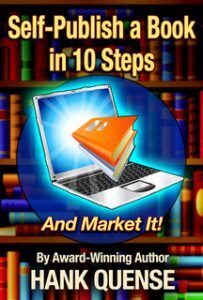 This article describes a workable ten step plan. To use it, the author will need to perform research to flesh out the details in each step. An alternative is to use the details in my new book, Self-publish a Book in 10 Steps. It will be available for pre-order on November 15 and will be published on December 1, 2021. It’s available from Amazon and other book sellers.
This article describes a workable ten step plan. To use it, the author will need to perform research to flesh out the details in each step. An alternative is to use the details in my new book, Self-publish a Book in 10 Steps. It will be available for pre-order on November 15 and will be published on December 1, 2021. It’s available from Amazon and other book sellers.
 Hank Quense’s website Writers & Authors Resource Center provides material relating to fiction writing, self-publishing and book marketing.
Hank Quense’s website Writers & Authors Resource Center provides material relating to fiction writing, self-publishing and book marketing.
A 10-Step Plan to Self-Publishing a Book (by @hanque99 ):
Click To Tweet
Photo credit: shixart1985 on VisualHunt.com
The post 10-Step Plan to Self-Publish a Book appeared first on Elizabeth Spann Craig.
November 13, 2021
Twitterific Writing Links
by Elizabeth S. Craig, @elizabethscraig
Twitterific writing links are fed into the Writer’s Knowledge Base search engine (developed by writer and software engineer Mike Fleming) which has over 61,000 free articles on writing related topics. It’s the search engine for writers. While you're there, check out the Writer's Digest award-winning Hiveword novel organizer.
Have you visited the WKB lately? Check out the new redesign where you can browse by category, and sign up for free writing articles, on topics you choose, delivered to your email inbox! Sign up for the Hiveword newsletter here.
Business / MiscellaneousNarrative Design In The Gaming Industry: @edmcraewriter @thecreativepennBecoming a non-fiction editor: 4 things you need to know: @LouiseHarnbyBook Pre-Orders to Grow Your Author Business: @dkparsonswriter @OrnaRoss @IndieAuthorALLIAuthor Headshots: Making the Most of your Photographer: @sacha_black @LastmanPhotoStart Your Freelance Writing Career with These 7 Simple Steps: @seejavaciawriteHow to Get an Amazon Author Page: by Arielle Haughee @FloridaWriters1Business Musings: International Growth (Jumping The Digital Divide): @KristineRuschFreelancing: 7 Things To Do When You Miss A Deadline: @ashleygainer5 Types of Editing: Which One Do You Need Right Now? @ReedsyHQConferences and Events / MiscellaneousSharjah: Abu Dhabi Arabic Language Centre Releases Harari’s ‘Homo Deus’: @Porter_Anderson @pubperspectivesCONTEC México 2021: Focus on a ‘New Generation of Children’s Content’: @Porter_Anderson @pubperspectivesA Digital Festival Neue Literatur 2021: ‘Turn and Face the Strange’: @Porter_Anderson @pubperspectivesEvent Tips n’ Tricks for the Vain, Shallow, and/or Insecure: by Liza Nash Taylor @WriterUnboxedAspen Institute Names Its 2022 Aspen Words Literary Prize Longlist: @Porter_Anderson @AspenInstitute @pubperspectivesLondon’s Young Writer Award of the Year Names Its Jurors: @Porter_Anderson @YoungWriterYear @pubperspectivesLondon's 2021 FutureBook Conference : Live and Streaming, November 19: @Porter_Anderson @pubperspectivesCanada’s 2021 Scotiabank Giller Prize Goes to Omar El Akkad: @Porter_Anderson @pubperspectivesCreativity and Inspiration / First NovelsHow to Create a Story: @GoodStoryCoCreativity and Inspiration / InspirationChasing My Muse: @thatpluckygirl @DIYMFA75 Dialogue Prompts for Writers: by Gloria RussellTarot Cards for Writing Inspiration: by Willow Croft @HorrorTreeCreativity and Inspiration / Inspiration / Reading as Writers9 of the Worst Jobs in Literature: by Sophie Stein @ElectricLit8 Thrillers about Women Breaking Free, Losing Control, and Taking Charge: @JayeViner @CrimeReadsThe Only Way Out Is Through: On Reading Slumps: @mollytempleton @tordotcomFive Books Where Gods Walk the Earth: @leslyepenelope @tordotcomReading Generously: Sacred Reading with ‘Jane Eyre’: @meganwillome @tspoetryStories Where Speculative Fiction Intersects with Crime Fiction: @MargotKinberg7 Funny Novels About the Internal Politics of Working at a Newspaper: by Katherine Ashenburg @ElectricLitCreativity and Inspiration / MotivationGet Started With Your Next Novel: by Erwin Wunderlich @FloridaWriters1Creativity and Inspiration / Productivity / Fitting in WritingA Writer’s Two Worlds: @MorganHzlwood6 Factors to Becoming Super Productive: @LiveWriteThriveCreativity and Inspiration / Writing LifeA Teen Writer's Perspective and Tips: @HermioneLee7 @TheIWSG21 of the most unusual novelty bookshelves you can buy: @knownemily @lithubWhen is it Time to Share My Writing? When to Hire an Editor? @LisaTenerStruggling with Writing Burnout? Try These Tricks: @ShannaSwendsonThree Simple Steps to a Satisfying Writing Session: @kristen_kiefferIs It a Good Idea to Write When You Don’t “Feel Like” Writing? @MegDowellEstablishing a Support Network as a Writer: @DanBlankThe Writing Life: Tips for New Writers: @MarkReutlinger @colleen_m_story12 More Reasons Not to Give Up on Your Writing Dreams: @MegDowell @TheRyanLanzAuthor Mindset: Strengths For Writers: @beck_a_tron @thecreativepennSelective Writer’s Block: When Some Things Are Better Left Unwritten: @eyeontheeast @WomenWritersHow Writers Really Spend their Days: by Dana Isaacson @CareerAuthorsGenres / FantasyWriting Fantasy: A Podcast on Giants: @mythcreants24 Jobs For Fantasy Characters: @ChrisLukeDean @Writers_WriteGenres / Horror6 Unique Traits To Be A Good Horror Writer: by Sherri Carrier @HorrorTreeGenres / MemoirThe Art of Endlessly Revising a Memoir: @anneliukellor @JaneFriedmanHumorous Memoirs: @BethKephart @CleaverMagazineGenres / MysteryCrime Fiction: The Murder's Impact on Other Characters in the Story: @MargotKinbergHow to Write a Mystery – A Handbook from Mystery Writers of America: @burke_writer @killzoneauthorsCrime Writing: “All I Really Need to Know I Learned Covering Homicides”: @keithroysdon @CrimeReadsFlawed Characters in Crime Fiction: @MargotKinbergGenres / Non-FictionHow to Use Fiction Techniques to Write Compelling Nonfiction: @NinaAmirCreative Nonfiction: by Michal Leah @GoodStoryCoGenres / Picture BooksHow to Make Six Figures Self-Publishing Children’s Books: @FictionNotes @JaneFriedmanGenres / RomanceRomance editing with Sarah Calfee: @LouiseHarnby @sacalfeeGenres / Screenwriting“How 50 Famous Female Characters Were Described In Their Screenplays”: @GoIntoTheStoryScreenwriting: Test Your Story Concept: @GoIntoTheStoryPage One: “The Terminator” (1984): @GoIntoTheStoryScreenwriting Back to Basics: Reader Identification: @GoIntoTheStoryScript To Screen: “The Devil Wears Prada”: @GoIntoTheStory“Screenplay Lessons Learned Adapting My Own Fiction”: @GiveMeYourTeeth @LitReactorBob Saenz Offers His Top 8 Screenwriting Tips: @Bang2writePromo / MiscellaneousHow to Design KDP A+ Content That Sells Books: from Author ImprintsHow to Market a Book While Keeping It Classy: @BookgalPromo / NewslettersHow to Get Readers to Unsubscribe from Your Mailing List: @inkbitspixels @FloridaWriters1Promo / Social Media TipsFacebook Parties for Promo: Tips: Publishing / MiscellaneousOn Acknowledgments (Video): @yuvizalkow @WriterUnboxed‘The 1619 Project' Books Arrive Amid Heated Debate: @Porter_Anderson @pubperspectivesHow to Publish Large Print Books and Why You Should: by Jason Hamilton @DaveChessonUNESCO Names 49 Additions to Its Creative Cities Network as Azoulay Wins: @Porter_Anderson Reelection @pubperspectivesNobel Laureate Abdulrazak Gurnah on Displacement, and ‘Ready Readers': @Porter_Anderson @pubperspectivesAfter 36 Rights Deals, ‘Station Eleven' Is Headed for Television: @Porter_Anderson @pubperspectivesPublishing / News / International PublishingFrench Youth Reading Sector: Glénat Acquires Hugo&Cie for Romance, Comics: @jaroslawadamows @pubperspectivesSharjah Book Fair's Guest of Honor Spain : ‘Our Roots are Deep and Close': @Porter_Anderson @pubperspectivesToronto's Annick Press : ‘Global Certified Accessible' in Canadian Ebooks: @Porter_Anderson @pubperspectivesSharjah: Abu Dhabi Arabic Language Centre Releases Hariri’s ‘Homo Deus’: @Porter_Anderson @pubperspectivesWorld Copyright Highlights in Late 2021: Michael Healy’s Overview: @Porter_Anderson @pubperspectivesUAE: IPA’s President Meets With the Emirates Publishers Association: @Porter_Anderson @pubperspectivesRights Roundup: A 102-Book Deal With Storytel in Stockholm: @Porter_Anderson @pubperspectivesPRH Canada’s Kristin Cochrane and Adrienne Tang: Frankfurt and Rights Sales: @Porter_Anderson @pubperspectivesPublishing / Options / Traditional PublishingThree Benefits of Writing a Book Proposal: @SpeerAuthor @NatalieIAguirrePublishing / Options / Traditional Publishing / QueryingTrigger warnings in queries? @Janet_ReidPublishing / Options / Traditional Publishing / Rejections“How I Learned To Embrace Rejections”: @brotzel_fiction @Writers_WritePublishing / Process / Services to AvoidPublishing Scammers are Proliferating like Tribbles: How to Stay Safe: @annerallenWriting Craft / BeginningsHow do You Start Writing Your Story in the Right Place? @ACW_Author @EdieMelsonMake your opening sparkle (page critique): @NathanBransfordWriting Craft / Characters / AntagonistsArchetypal Antagonists for Each of the Six Archetypal Character Arcs: @KMWeilandWriting Craft / Characters / DevelopmentCan Audiences Sympathize With My Honorable Character? by Oren Ashkenazi @mythcreantsCrafting Great Characters Starts and Ends with Motivation: @LiveWriteThriveMaking Your Characters Sound Different: by Marilynn ByerlyBuild a Character (Masterpost): from Souls CollideFour Ways to Take Your Characters from Cardboard to Real: @SarahSallyHamer @EdieMelsonCharacter Types: The Know it All: @JoanHallWrites @StoryEmpireHow Do I Portray an Ambitious Character? by Oren Ashkenazi @mythcreantsWriting Craft / Common Mistakes5 Ways Your Story Hurts Your Novel: @Janice_HardyMore Genre Clichés: @stacitroilo @StoryEmpireQuick Publishing Tip: Don’t Bury Your Gold: by Bucket SilerWriting Craft / Devices / RepetitionMind your language: Repetition, clichés and modifiers: @Andy_Maslen @AuthorsAiWriting Craft / DiversityIndigenous People as Colonizers: Why That’s Hurtful: @WritingwColorNaming a Chinese/Vietnamese character: @WritingwColorWriting Craft / Lessons from Books and FilmPage One: “The Revenant” (2015): @GoIntoTheStoryChoose Wisely: Ranking 25 Memorable Deaths in SFF: @cloudy_vision @tordotcomFive Villains With Contrived Wins: by Oren Ashkenazi @mythcreantsGreat Scene: “Amadeus” @GoIntoTheStoryWriting Craft / Miscellaneous“Write what you know.” Is this good advice? An agent answers: @RachelleGardnerThe Log-Line: Can You Pitch Your ENTIRE Story in ONE Sentence? @KristenLambTXThe Beginner’s Guide to Subplots: How To Write Them + 5 Subplots to Add To Your Novel: by Chelsea Hindle @KingdomPenMagWriting Craft / Pre-Writing / PlottingFour Aspects of a Riveting Plot and How to Apply Them: by Jodi Clark @KingdomPenMagWriting Craft / Punctuation and GrammarUse Semicolons to Your Advantage: @AJHumpageWriting Craft / RevisionPurple Prose and the Word Surgeon’s Scalpel: @TomBentleyNow @WriterUnboxedWriting Craft / ScenesWriting Scenes: Get Your Characters Moving: @LindasclareWriting Craft / Scenes / ConflictConflict is King…but how much is too much? by PJ SharonWriting Craft / TransitionsQuick editing tip: Passing time: from Bucket SilerWriting Tools / AppsHow to Use Vellum on Windows: A 2021 Guide: @DaveChesson
The Top Writing Links From Last Week Are On Twitterific:
Click To Tweet
The post Twitterific Writing Links appeared first on Elizabeth Spann Craig.
November 7, 2021
Facebook Parties for Promo
by Elizabeth S. Craig, @elizabethscraig
Facebook has always been a platform that I've struggled with. I rarely use my personal account, but I do maintain my professional account. I know I have a lot of readers using Facebook.
It's also a platform where I could have the ability to reach new readers…something I tried harder to do in 2020.
I chose to go through a service to run my Facebook parties last year. Marie McNary of A Cozy Experience did a fantastic job. Unfortunately, because of the pandemic, she is taking a break from running Facebook parties (she has kids she's having to homeschool, etc), but I hope she'll eventually come back. A quick search online showed that there are other businesses that offer similar services. You can expect to pay $85–$100. The nice thing about using a service was that they created the images and script for the party and handled the giveaway. Marie posted directly to the Facebook event invite and posted every 5 minutes for an hour. I answered comments and questions that Marie posted. She posted the giveaway winners to the page the next day.
But this isn't something you have to go through a service for. You can host a Facebook party yourself or join a group of authors doing one. (Joanna Campbell Slan hosted one last March that was a lot of fun. She assigned everyone a different time slot.)
Tips for Running Facebook PartiesDecide on your goal. The goal could be a number of different things: more Facebook followers, more newsletter subscribers, more followers on Amazon or Goodreads, or just visibility in a crowded market.
Plan the party, including images. You can make sure your images are optimized for Facebook by using a free program like Canva.com.
Include giveaways. This is a great way to encourage new readers to discover your books. Be sure to set up parameters for the giveaway…digital copies? Print? Only open to readers in the continental US? It's also important to be aware of Facebook's rules for giveaways.
Include an image of books in your series. Make sure one of the posts you run shows your series or book. It's said that The Marketing Rule of 7 still applies to modern purchases, so you want potential readers to see your covers and get familiar with your books for a possible later purchase.
Include a post including your contact information. This is a great way to get new followers, subscribers, or for readers to be able to reach out with further questions. Including your website address helps readers find out more about your books.
Keep refreshing the page to see new comments. Facebook doesn't do a good job of refreshing and if you don't manually do it, you may find that you're far behind in responding right off the bat.
Respond to and like comments. It may be hard to keep up in real time, but if you accidentally miss a couple, you can go back later to reply. The whole exercise is supposed to be a virtual meet-and-greet, though, so eventually responding to and liking comments is important.
Have you thrown Facebook launch parties or other Facebook parties? How did it go? What other promo activities have you tried out recently?
Tips for Facebook Parties:
Click To Tweet
Photo on Visualhunt.com
The post Facebook Parties for Promo appeared first on Elizabeth Spann Craig.

